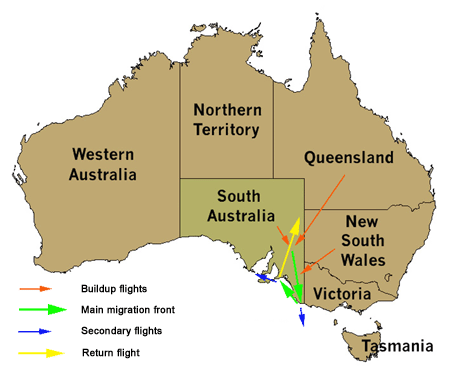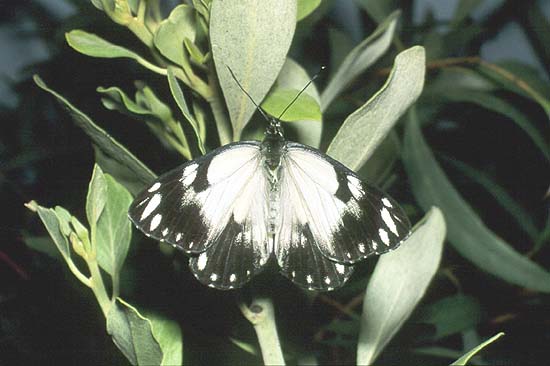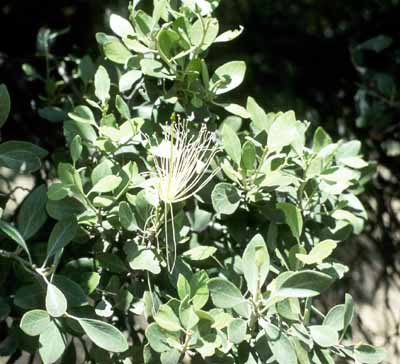
Caper White Migration in 1999
It will soon be time for migrating butterflies to start their annual migrations from the northern areas of South Australia. Most will fly south. Some will make it to Marion, where most will simply pass through and continue on flying south, but a few will stay to take up residence.
Certain groups of butterflies, such as the whites and yellows, and brush-foot butterflies, are known to form large migratory groups. The Caper White is one of those butterflies. It was this butterfly that recently passed through Marion in the thousands during 1999. Every year, these butterflies fly south during late spring from their breeding grounds in the North Flinders Ranges, and the inland areas of NSW and Qld, eventually reaching the suburbs of Adelaide. In most years only a few reach Adelaide, while infrequently, phenomenally large groups of the butterflies make it to Adelaide. The year 1999 was one of the phenomenal years, making it a once in a lifetime occasion for Marion residents. Although the butterflies usually fly south, they can actually disperse in any direction and migrations have been reported in Sydney and Brisbane, and occasionally they even reach Tasmania. Yet it is not known why they should fly south to colder areas where their caterpillar foodplants do not exist.
There have been no investigations into these migrations in Australia. For example, it is not known exactly from where they originate, how long the migrations take, how fast individuals fly, how far can they travel in a day, how do they navigate, how do they all synchronize their flight, does the entire migration occur as a single mass or does the group build up gradually along the chosen route, etc. For the interest of readers an attempt has been made to assemble the fragments of information received from the public relating to the big Caper White migration of 1999.
On September 3, 1999, spring was heralded by a gale force north wind in South Australia. On September 6, the first Caper White butterflies for the season were noticed as odd individuals in southern areas. Only odd individuals continued to be noticed through September and October.
In early November, small local groups of the butterflies were seen collecting in forest and woodland areas of the Lower Southeast Region. November was an unusual month for wind direction in South Australia, with the wind direction being mostly from the hot northeast, and during the final week the wind was almost entirely from the northeast.
Then on November 23 a very large migratory front of the butterflies was noticed in the Riverland flying from north to south, heading to the Southeast. The front amalgamated with the smaller groups in the region, and they all continued flying south. Flocks started flying out to sea on November 26 and thousands of butterflies perished and were washed up on the beaches the following day.

Then the migration turned west and by November 29 they started to reach Murray Bridge. Late in the afternoon, huge numbers inundated the southern coastal Fleurieu Peninsula, from Goolwa in the east to Victor Harbor and along the west side of the peninsula to as far north as Marion in suburban Adelaide. In many places they were coming in off the sea. They spent the night by the hundreds at the same areas, hanging in the bushes and settling on the ground like 'snow'. Some even came to night-lights.
*Notes: Interestingly, nobody bothered to photograph the 'butterfly snow', so we cannot show you a picture!
On November 30 the migration was in full swing through the entire Fleurieu Peninsula, where the migration front now changed direction to north-northeast. Those butterflies at Marion woke early, had a feed from available flowers, and then by 9:00am were on their way again.

At Victor Harbor they were still coming in off the sea from the southeast, and continuing on to Yankalilla. When flying in off the sea they were flying in small flocks or groups, of 20's to hundreds. Others on the east side of the peninsula were flying in flocks north through Goolwa and Currency Creek, while newcomers were still arriving at Goolwa from the southeast.
Large numbers were also still flying in the Southeast at Carpenters Rocks and Robe, flying northwest towards Adelaide. The flights extended to Kangaroo Island and the butterfly was reported in large numbers over the entire length of the island. Some even reached southern Yorke Peninsula and southern Eyre Peninsula. Along the west side of the Fleurieu Peninsula they were generally flying north-northeast following the west side of the Mt Lofty Ranges.
Both sexes were flying in the main migration. There were reports of many road kills, with magpies and other birds eating the carcasses. Late in the afternoon, estimates of numbers in the migration were made in the open spaces of Waite Arboretum, where a line of sight count over a 50 metre distance recorded 650 individuals per hour. In the late afternoon the butterflies were seen to be flying in off the sea along Adelaide's beaches, then settling in large numbers along the foreshore bushes to overnight. They had all gone by the next day.
December 1 was another hot day with a strong northeast wind. The Caper Whites were now migrating in lesser numbers through suburban Marion, flying into the wind along the hills face. Butterflies were still actively migrating through Goolwa, and large numbers were still flying in off the St Vincents Gulf. A check of numbers at the Waite Arboretum in the morning showed 440 individuals per hour crossing over a line of sight distance of 100 m, but by late afternoon only 60 individuals were crossing the 100 m distance in an hour.
December 2 was a very hot day with a very strong north wind, and the migration through Marion and Adelaide was mostly over, with just a few butterflies continuing to migrate in a north-northeast direction, but with just as many being carried back in a south direction by the wind.
By December 3 the migration was essentially all over in Adelaide with just the odd butterfly seen. Where the migration went after Adelaide is not known, but they did not pass through the Riverland or Clare, and it is assumed they flew along the east side of the ranges, and headed back northeast to where they originated from. If they originated from inland NSW it would have been a round trip of 1300 km through Adelaide, but if the origin was Qld it would have been 3000 km and comparable to the migrations of the large brown Monarchs (Wanderers) in North America.

Their natural caterpillar foodplants such as the Tree Caper occur in the hot northern inland areas, but a couple of specimens are maintained in the Botanic Gardens and Waite Arboretum. During big migrations, the females deposit thousands of eggs on these trees as they pass through, producing caterpillars that often damage the foliage. Due to predation, very few of these caterpillars will actually produce new butterflies.
Other butterflies are also known to migrate in South Australia, and they usually do so in spring, flying in a general south direction. These migrations now occur almost unnoticed due to the reduced number of butterflies taking part in the migration, caused by the loss of inland breeding habitat. Historically, they once migrated in huge numbers, with the Painted Ladies once being so numerous as to darken the sky in Victoria. The migrant butterflies should start to be seen in Marion by mid August and they will continue throughout spring.
Initially there will be Painted Ladies, Meadow Argus, Admirals, Lesser Wanderers, and the large Chequered Swallowtails, and later the Small Grass Yellows and the Caper Whites. The latter two will pass through Marion as there is no caterpillar foodplant present for the female butterflies to lay eggs. However, some of the previous butterflies will remain to lay eggs to produce new butterflies in parks and home gardens. Late in autumn most of the new butterflies will return to the northern breeding grounds.
The large brown Monarch or Wanderer butterfly, now established in Marion, is a notable migrant in North America where very large numbers migrate annually between Canada, and California and Mexico (in particular) where huge overwinter clusters can occur. Similar overwintering clusters once used to occur in the Adelaide Hills, but the removal of its caterpillar milkweed foodplants has now significantly reduced numbers of this butterfly. Large migrations of this butterfly do not occur in Australia. However, the butterfly is not endemic to Australia (as we do not have any suitable native foodplants for its caterpillars), but it immigrated to Australia from North America by island hopping across the Pacific Ocean.